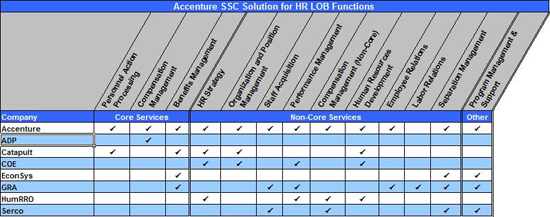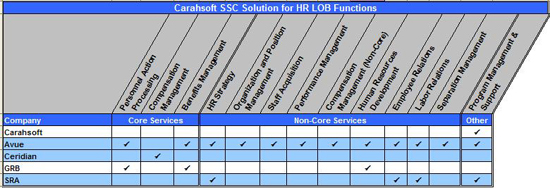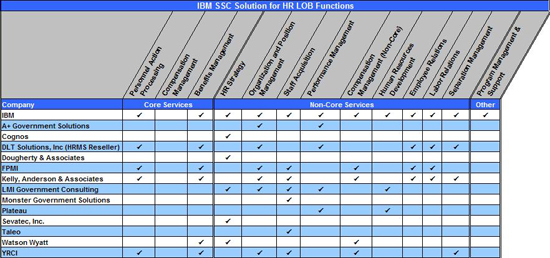U.S. Office of Personnel Management - Ensuring the Federal Government has an effective civilian workforce
E-Gov - Human Resources Line of Business - HR LOB
Skip Navigation- HR LOB Enterprise Architecture
- Requirements
- Migration Planning Guidance
- Standardization
- Strategic HR
- Archives
Documents
Migration Planning Guidance
6. Service Delivery
6.1 Public Sector SSCs
In August 2005 the OPM Director announced the selection of five public sector SSCs:
Department of Agriculture's National Finance Center (NFC)
Department of Defense (DoD)
Department of Health and Human Services (HHS)
Department of Interior's National Business Center (NBC)
Department of Treasury (Treasury)
All of the public sector SSCs have the capability to meet the HR LOB concept of operations and at a minimum deliver the mandatory core SSC requirements. Differences do exist, however, in areas including SSC core technologies, service delivery models, and schedule for customer migrations. SSC service offering summary information is provided below:
| Public Sector Shared Service Center | System Base | Payroll Provider | HR Staff Support Services (Non-HRIT) |
|---|---|---|---|
| USDA NFC | Payroll/Personnel System (PPS) and stand alone HR (EmpowHR) and T&A (Web Star) | NFC | Partnered with Animal and Plant Health Inspection Service (APHIS) |
| DoD | Defense Civilian Personnel Data System (DCPDS) with Payroll interface | Interface to DFAS | Aligned to DoD Regional Service Centers |
| HHS | CapitalHR | Interface to DFAS | HHS SSC Resources |
| DOI NBC | Federal Personnel and Payroll System (FPPS) and Quicktime (T&A) | NBC | NBC SSC Resources |
| Treasury | HR Connect | Interface to NFC | Partnered with Bureau of Public Debt (BPD) |
Table 2: Public Sector SSC Offerings Summary
6.1.1 Service Delivery Model: Department of Agriculture's National Finance Center (NFC)
The Department of Agriculture, through the National Finance Center (NFC), offers the Payroll/Personnel System (PPS). The PPS provides a full range of integrated HR, Payroll and time and attendance services. The NFC also offers Web Star, a web based time and attendance system and EmpowHR, a web based PeopleSoft HR application.
Together, the PPS, Web Star, and EmpowHR support employees in 50 agencies. The PPS is an integrated in-house developed personnel and payroll system. Web Star is also developed in-house. EmpowHR, which interfaces to PPS, is a PeopleSoft application. All of the systems are maintained in-house.
NFC supports non-IT services through its partnership with the Animal and Plant Health Inspection Service (APHIS). NFC's service offering for the HR LOB functions is summarized as follows:

Figure 3: USDA-NFC SSC Solution for HR LOB Functions Matrix
6.1.2 Service Delivery Model: Department of Defense (DoD)
The Department of Defense (DoD), through the Civilian Personnel Management Service (CPMS), offers the Defense Civilian Personnel Data System (DCPDS). CPMS, in partnership with the Defense Finance and Accounting Service, provides payroll and time & attendance services.
DCPDS is DoD's enterprise civilian HR information management and transaction processing system supporting DoD and non-DoD civilian employees. DoD also maintains support for the Executive Office of the President and the Broadcasting Board of Governors. The HR IT system is an Oracle-based, customized system for which CPMS is responsible for functional and technical oversight.
Non-IT services are provided through 22 DoD Regional Service Centers (RSCs) and advice and assistance is provided by multiple Customer Support Units (CSUs) worldwide. The RSCs and CSUs are owned by the Army, Navy, Air Force, the National Guard Bureau, and DoD agencies. Customer agencies desiring support would be aligned with this same service delivery model. DoD's service offering for the HR LOB functions is summarized as follows:

Figure 4: DoD SSC Solution for HR LOB Functions Matrix
6.1.3 Service Delivery Model: Department of Health and Human Services (HHS)
The Department of Health and Human Services (HHS), through the Program Support Center (PSC), offers the CapitalHR system. The PSC, in partnership with the Defense Finance and Accounting Service, provides payroll and time and attendance services.
CapitalHR is HHS' enterprise civilian HR information management and transaction processing system. Currently HHS maintains support for internal customers only. The HR IT system is a PeopleSoft based, customized system and the PSC is responsible for functional and technical oversight.
Non-IT services for new HHS customers will be provided through a newly established HR service center. Customer agencies desiring non-IT support would be aligned with this service delivery model. HHS' service offering for the HR LOB functions is summarized as follows:

Figure 5: HHS SSC Solution for HR LOB Functions Matrix
6.1.4 Service Delivery Model: Department of Interior's National Business Center (NBC)
The Department of the Interior, through the National Business Center (NBC), offers the Federal Personnel Payroll System (FPPS). The FPPS provides a full range of HR, payroll and time and attendance services. The NBC also offers time and attendance support through the web based Quicktime system.
The FPPS is NBC's enterprise integrated HR/payroll information management and transaction processing system supporting employees in 40 agencies. The FPPS was developed in-house and is maintained in-house. The Quicktime system which is web based was also developed and is maintained in house.
Non-IT services are performed in its Denver, CO location and is comprised of the full range of payroll operations such as benefits support, debt management, and payroll accounting. The NBC also offers a data center, and data warehouse for analytics, reporting, and auxiliary client systems and data repository. NBC's service offering for the HR LOB functions is summarized as follows:

Figure 6: DOI-NBC SSC Solution for HR LOB Functions Matrix
6.1.5 Service Delivery Model: Department of Treasury (Treasury)
The Department of Treasury offers the HR Connect system. The Treasury, in partnership with the National Finance Center, provides payroll and time and attendance services. In addition to interfacing with NFC, the Treasury will also provide interfaces to other payroll providers as well as other ala carte systems/services.
The HR Connect is Treasury's enterprise web-based PeopleSoft HR application. The solution offers a wide range of HR IT functionality including base benefits, Employee/Manager Self Service, proxy authority, change management, training, and business intelligence/workforce analytics capabilities. The HR Connect currently services employees of the Department of the Treasury, Department of Housing and Urban Development (HUD) and employees within components of the Departments of Homeland Security and Justice.
Treasury supports non-IT services through its partnership with the Bureau of Public Debt (BPD)'s Administrative Resource Center (ARC). Treasury's service offering for the HR LOB functions is summarized as follows:

Figure 7: Treasury SSC Solution for HR LOB Functions Matrix
6.2 Private Sector SSCs
By January 2008, GSA and OPM had announced the selection of four private sector SSCs:
Accenture National Security Services (Accenture)
Allied Technology Group, Inc. (Allied)
Carahsoft Technology Corporation (Carahsoft)
International Business Machines (IBM)
Accenture, Allied, and Carahsoft offer all of the mandatory core and non-core SSC functions. IBM offers the mandatory core functions for Personnel Action Processing and Benefits Management services and all non-core SSC functions, but is not approved at this time to deliver core Compensation Management services.
Differences exist among the private sector SSC solutions in areas including SSC core technologies, service delivery models, and schedule for customer migrations. SSC service offering summary information is provided below:
| Public Sector Shared Service Center | System Base | Payroll Provider | HR Staff Support Services (Non-HRIT) |
|---|---|---|---|
| Accenture | Oracle/PeopleSoft Human Resource Management System (HRMS) and ADP | ADP or Interface to Government e-Payroll Providers | Accenture, Catapult Technology, EconSys, GRA, HumRRO, Serco and COE |
| Allied | Avue ADS Platform including GRB's EBIS and Ceridian | Ceridian or Interface to Government e-Payroll Providers | Allied Technologies, SRA |
| Carahsoft | Avue ADS Platform including GRB's EBIS and Ceridian | Ceridian or Interface to Government e-Payroll Providers | Carahsoft Technology, SRA |
| IBM | Oracle/PeopleSoft Human Resource Management System (HRMS) | Interface to Government e-Payroll Providers | IBM, A+ Technologies, Cognos, DLT Solutions, DAI, FPMI, KAA, Monster, Plateau, and Taleo |
Table 3: Private Sector SSC Offerings Summary
6.2.1 Service Delivery Model: Accenture
Accenture offers Federal agencies Personnel Action Processing, Benefits Management, Compensation Management, and all non-core HR functions. Accenture offers Oracle/PeopleSoft Human Resource Management System (HRMS) together with ADP as the core solution to provide the full range of HR, time and attendance, and payroll services. Accenture also offers bi-directional interface capability with existing Government e-Payroll providers, such as NFC, for those agencies who decide not to select Accenture/ADP for payroll services. Accenture offers self-service Benefits Management capabilities through its eOrientation web-enabled tool for new employees, the HRMS Portal for existing employees, and optional access to Federal Retirement Benefits (FRB) for retirement planning through its partnership with Economic Systems, Inc. (EconSys).
Accenture, together with its partners Catapult Technology, GRA, Human Resources Research Organization (HumRRO), Serco and The Center for Organizational Excellence (COE), provide primarily the non-core HR services of the HR LOB SSC. Accenture's service offering for the HR LOB functions is summarized as follows:

Figure 8: Accenture SSC Solution for HR LOB Functions Matrix
6.2.2 Service Delivery Model: Allied
Allied offers Federal agencies Personnel Action Processing, Benefits Management, Compensation Management, and all non-core HR functions. Allied offers the Avue Digital Services (ADS) Technology Platform together with Government Retirement Benefits (GRB), Employee Benefits Information System (EBIS), and Ceridian to provide core SSC services. Allied, together with SRA, provides the non-core HR services of the HR LOB SSC. Allied's SSC service offering for the HR LOB functions is summarized below:

Figure 9: Allied SSC Solution for HR LOB Functions Matrix
6.2.3 Service Delivery Model: Carahsoft
Carahsoft offers Federal agencies Personnel Action Processing, Benefits Management, Compensation Management, and all non-core HR functions. Carahsoft offers the Avue Digital Services (ADS) Technology Platform together with Government Retirement & Benefits (GRB), Employee Benefits Information System (EBIS), and Ceridian to provide core SSC services. Carahsoft, together with SRA, provides the non-core HR services of the HR LOB SSC. Carahsoft's SSC service offering for the HR LOB functions is summarized below:

Figure 10: Carahsoft SSC Solution for HR LOB Functions Matrix
6.2.4 Service Delivery Model: IBM
IBM has been approved to offer Federal agencies Personnel Action Processing, Benefits Management, and all non-core HR functions. IBM offers Oracle/PeopleSoft Human Resource Management System (HRMS) to support the mandatory core SSC services. IBM offers self-service Benefits Management capabilities through the HRMS Portal and access to OPM's Employee Express with a bi-directional interface. At this time, IBM does not offer core Compensation Management services. IBM, together with its partners A+ Government Solutions, Cognos, Dougherty & Associates, Taleo, Watson Wyatt, and YRCI, provides the non-core HR services of the HR LOB SSC. IBM's SSC service offering for the HR LOB functions is summarized below:

Figure 11: IBM SSC Solution for HR LOB Functions Matrix
6.3 Other Providers
Twenty-six Federal payroll providers have been consolidated to four. While two of the four current e-Payroll providers have also been approved as HR LOB SSCs, two e-Payroll providers have chosen to continue providing e-Payroll services only. The General Services Administration and the Defense Finance and Accounting Service will continue to exist as stand alone payroll providers and will offer payroll operations through partnerships with shared service centers.
General Services Administration's National Payroll Branch (NPB)
The NPB, a component of the General Services Administration, is located in Kansas City, MO. GSA services GSA and 33 non-GSA agencies. It offers a payroll solution that supports a standard HR interface used by all of its customers.
Department of Defense's Defense Finance and Accounting Service (DFAS)
DFAS, a component of the Department of Defense (DoD), has payroll locations in Indianapolis, IN, and Cleveland, OH. DFAS services all components within the Department of Defense and six (6) other non-Defense agencies. It offers a payroll solution that supports a standard interface to various HR solutions.
6.4 Target Requirements Self-Evaluations
The SSCs and e-Payroll Providers documented their ability to meet the HR LOB Target Requirements for Shared Service Centers. The self-evaluations linked in this section contain evaluation matrices for the SSCs to self-evaluate their capabilities against the target requirements. SSCs are expected, at a minimum, to meet all applicable mandatory requirements for Personnel Action Processing and Benefits Management. If an SSC provides services for Compensation Management (payroll operations) or any of the non-core functions, they must meet the applicable mandatory requirements at the time such services are provided to customer agencies.
Structure and Content
The self-evaluations are comprised of two major sections:
Core Requirements Self-evaluations. (Sub-sections I-a through I-c). These pages contain the core requirements for SSCs.
Non-core Requirements Self-evaluations. (Sub-sections II-a through II-i). These pages contain the non-core requirements for SSCs.
The first four columns are from the HR LOB Target Requirements for Shared Service Centers. They are:
Unique ID - the identifier given to the requirement.
Requirement Description - the expectation being set regarding the service to be provided.
Priority - designation given to each requirement to document the relative significance of the requirement:
Mandatory - a Mandatory requirement supports an essential mission-critical business need, statutory requirement and/or regulatory requirement that must be implemented and met.
Mandatory* - indicates that the requirement may be governmentwide or may apply only to the provider solution that supports a specific agency need (applies to some, not all, agencies; if an SSC services an agency to which the requirement applies, it must meet the requirement).
Critical - a Critical requirement supports an essential business need that is likely to become Mandatory at some point in the future.
Useful - a Useful requirement supports an important but nonessential business need that may become Critical or Mandatory at some point in the future.
Who - identifies who will be responsible for meeting the requirement.
The rightmost three columns of the self-evaluation matrix contain the SSCs' evaluations against the HR LOB Target Requirements for Shared Service Centers:
Evaluation Code - for each requirement, the SSC determined whether it meets the requirement, partially meets the requirement or does not meet the requirement.
Implementation Date - for each requirement the SSC does not meet but intends to meet - Evaluation Code (N) or (P) - it indicated the date it will meet the requirement.
Comments:
For (P) partially met requirements, the SSC explained what can and cannot be met.
For (N) unmet Mandatory requirements where 'implementation date' is blank and the 'who' is "Shared Service Center and / or Agency", the SSC explained its expectations of customer agencies.
The SSC provided any other information it believes to be relevant.
The bottom of each sub-section contains a brief description of services to be delivered by the SSC.
SSC Self-evaluations
The SSC self-evaluations are linked for the following providers:
NFC
DoD
HHS
NBC
Treasury
Accenture
Allied
Carahsoft
IBM
DFAS (Compensation Management only)
GSA (Compensation Management only)
Use this link to gain access to our Self-Evaluation database.